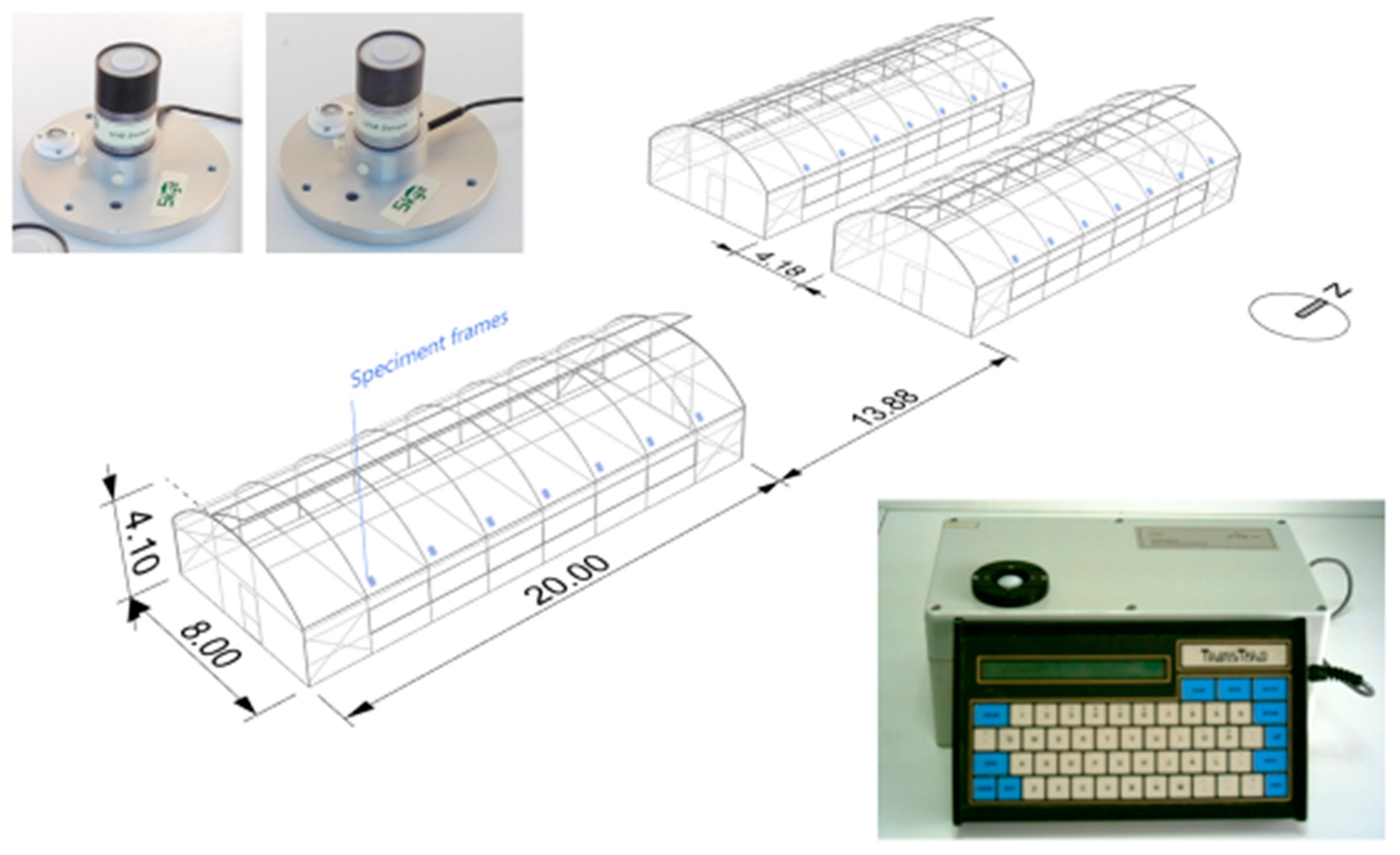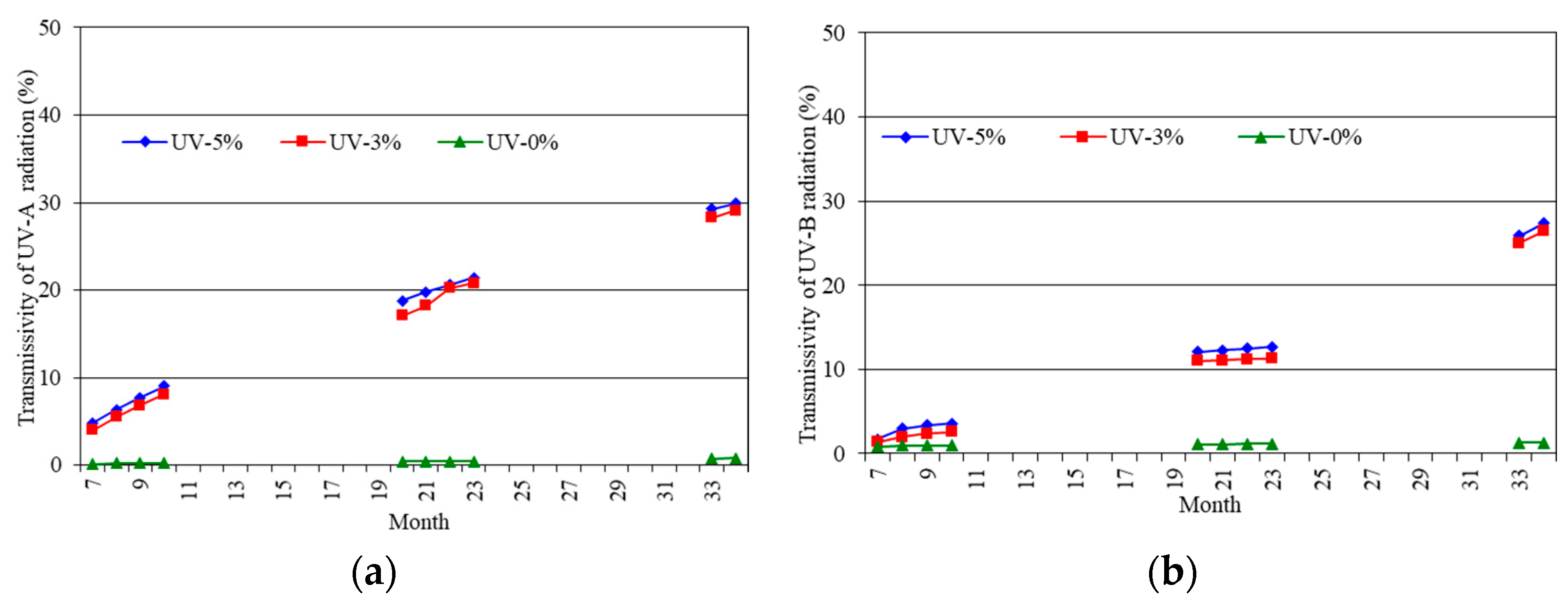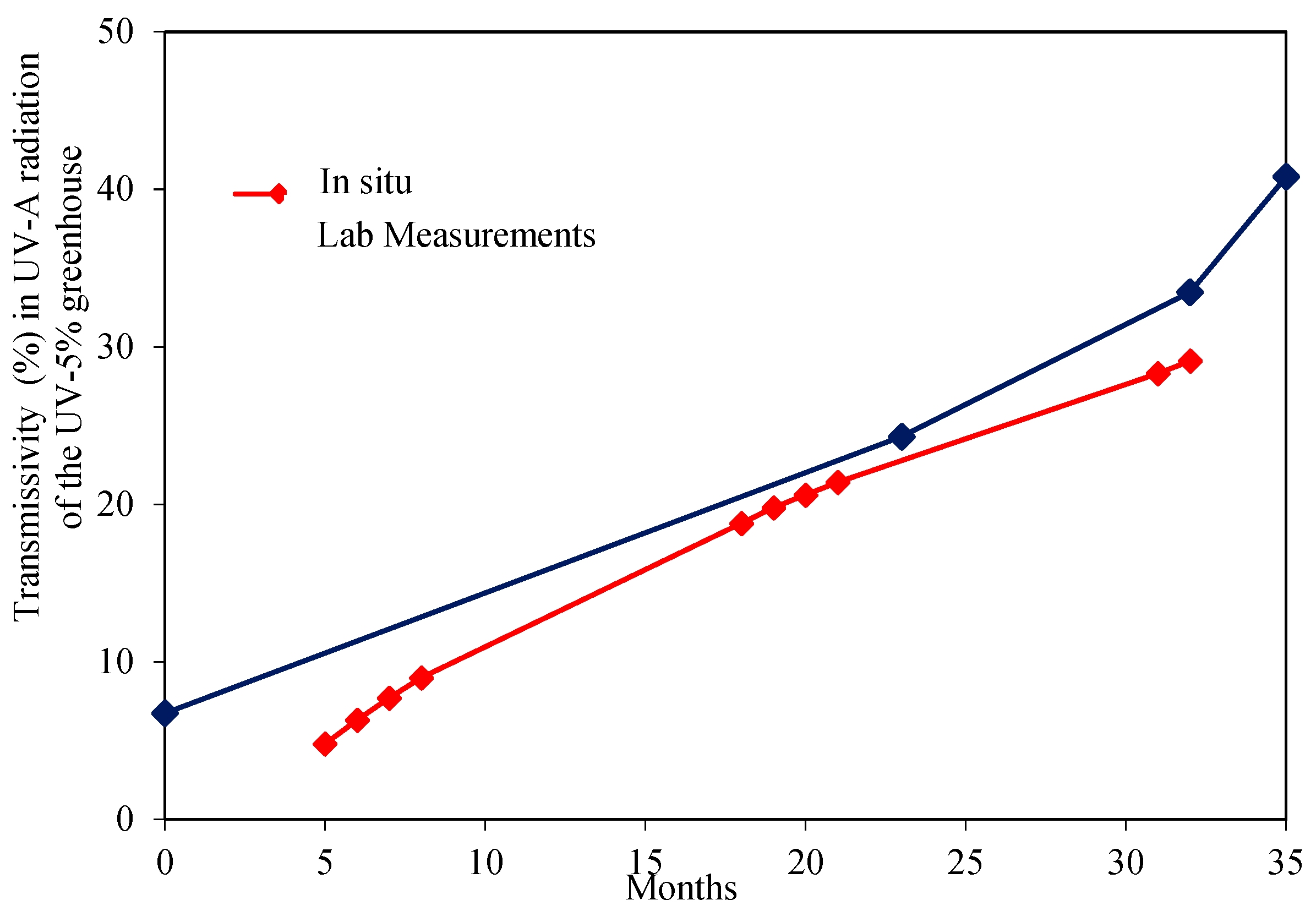Reduction in Blockage Property of UV-Blocking Greenhouse Covering Material: In Situ and Lab Measurement Comparison
Abstract
:1. Introduction
2. Materials and Methods
2.1. Greenhouse Facilities
2.2. Measurements
- (a)
- Laboratory measurements were conducted using a LI-COR portable spectroradiometer (LI-1800), (Figure 1), measuring in the range of 350 nm to 1100 nm, equipped with a 10 W glass halogen lamp and an external integrating sphere (LI-1800-12S) internally coated with barium sulphate. Details concerning the instrument and measuring technique are given by Kittas and Baille (1998) [14]. The samples were cut off each greenhouse roof (same position) and washed.
- (b)
- In-situ measurements were conducted using UV-B (290–315 nm, W m−2, model SKU 430, Skye Instruments Ltd, U.K.) and UV-A sensors (315–380 nm, W m−2, model SKU 420, Skye Instruments Ltd, U.K.) installed inside and outside each greenhouse (Figure 1). Values were collected on a data logger system (model DL3000, Delta-T Devices, Cambridge, U.K.) every 30 s, and 10-min average values were recorded.
3. Results
4. Discussion
5. Conclusions
Author Contributions
Funding
Institutional Review Board Statement
Informed Consent Statement
Data Availability Statement
Conflicts of Interest
References
- Antignus, Y.; Lapidot, M.; Hadar, D.; Messika, Y.; Cohen, S. Ultraviolet-absorbing screens serve as optical barriers to protect crops from virus and insect pests. J. Econ. Entomol. 1998, 9, 1401–1405. [Google Scholar] [CrossRef]
- Costa, H.S.; Robb, K.L. Effects of ultraviolet-absorbing greenhouse plastic films on flight behavior of Bemisia argentifolii (Homoptera: Aleyrodidae) and Frankliniella occidentalis (Thysanoptera: Tripidae). J. Econ. Entomol. 1999, 92, 557–562. [Google Scholar] [CrossRef]
- Secker-Esquira, I. Effect of UV absorbing plastic covers on bumblebees in tomato greenhouses. In Proceedings of the 15th International Congress for Plastic in Agriculture, Hershey, PA, USA, 23–27 September 2000; pp. 150–151. [Google Scholar]
- Costa, H.S.; Robb, K.L.; Wilen, C.A. Fields trials measuring the effects of ultraviolet-absorbing greenhouse plastic films on insect populations. J. Econ. Entomol. 2002, 95, 113–120. [Google Scholar] [CrossRef] [PubMed]
- Monci, F.; García-Andrés, S.; Sánchez, F.; Moriones, E.; Espí, E.; Salmerón, A. Tomato Yellow Leaf Curl disease control with UV-blocking plastic covers in commercial plastichouses of southern Spain. Acta Hortic. 2004, 633, 537–542. [Google Scholar] [CrossRef]
- González, A.; García-Alonso, Y.; Espí, E.; Fontecha, A.; Salmerón, A. Viral diseases control with UV-blocking films in greenhouses of southern Spain. Acta Hortic. 2004, 659, 331–338. [Google Scholar] [CrossRef]
- Katsoulas, N.; Bari, A.; Papaioannou, C.H. Plant responses to UV blocking greenhouse covering materials: A review. Agronomy 2020, 10, 1021. [Google Scholar] [CrossRef]
- Dilara, P.A.; Briassoulis, D. Degradation and stabilization of Low-density Polyethylene Films used as Greenhouse Covering Materials. Review Paper. J. Agric. Eng. Res. 2000, 76, 309–321. [Google Scholar] [CrossRef]
- Kittas, C.; Katsoulas, N.; Katsoupa, M.; Papaioannou, C.H. Test of a greenhouse covered by polyethylene film that reflects near infrared radiation. Acta Hortic. (ISHS) 2012, 956, 507–513. [Google Scholar] [CrossRef]
- Srivastava, D. Study of aging characteristics of ternary blends of polyethylenes-II. J. Polym. Environ. 2004, 12, 27–33. [Google Scholar] [CrossRef]
- Scarascia Mugnozza, G.; Vox, G.; Stefani, L. Effect of the pesticides on the degradation of EVA plastic films for greenhouse covering. In Proceedings of the 15th International Congress for Plastics in Agriculture, Hershey, PA, USA, 23–27 September 2000; Siegel, R., Howell, J., Eds.; pp. 141–149. [Google Scholar]
- Gilby, G.W. Speciality horticultural films, based on polyethylenes, for greater control of the growing environment. In Proceedings of the 11th International Congress on the Use of Plastics in Agriculture, New Delhi, India, 26 February–2 March 1990; pp. G67–G73. [Google Scholar]
- Espí, E.; Salmerón, A.; Fontecha, A.; García, Y.; Real, A.I. Plastic films for agricultural Applications. J. Plast. Film. Sheeting 2006, 22, 85. [Google Scholar] [CrossRef]
- Kittas, C.; Baille, A. Determination of the spectral properties of several greenhouse cover materials. Evaluation of specific parameters related to plant response. J. Agric. Eng. Res. 1998, 71, 193–202. [Google Scholar] [CrossRef]
- Lopez-Marin, J.; Gonzalez, A.; Egea-Gilabert, C.; Fernandez, J.A. Effect of different greenhouse covering photoselective films on yield and quality of tomato. In Proceedings of the VII Congresso Iberico de Agroingenieria y Ciencias Horticolas, Madrid, Spain, 26–29 August 2013. [Google Scholar]
- Giacomelli, G.; Ting, K.C.; Fang, W. Wavelength Specific Transmission of PE film Greenhouse Glazing. NJAES Publication No. #D03130-27-89. In Proceedings of the 22nd National Agricultural Plastics Congress, Montreal, QC, Canada, 21–25 May 1990; pp. 129–131. [Google Scholar]
- William, J.R. Glazing Materials, Structural Design, and Other Factors Affecting Light Transmission in Greenhouses. In Greenhouse Glazing and Solar Radiation Transmission Workshop; Center for Controlled Environment Agriculture, Rutgers University: New Brunswick, NJ, USA, 1998. [Google Scholar]
- Maraveas, C. Environmental sustainability of greenhouse covering materials. A Review. Sustainability 2019, 11, 6129. [Google Scholar] [CrossRef] [Green Version]
- Vatsanidou, A.; Bartzanas, T.; Papaioannou, C.; Kittas, C. Efficiency of physical means of IPM on insect population control in greenhouse crops. Acta Hortic. 2011, 893, 1247–1254. [Google Scholar] [CrossRef]




| UV-A | UV-B | ||||||
|---|---|---|---|---|---|---|---|
| UV-5% | UV-3% | UV-0% | UV-5% | UV-3% | UV-0% | ||
| March | 1st year | 4.8 | 4.0 | 0.1 | 1.7 | 1.4 | 0.8 |
| April | 6.3 | 5.5 | 0.2 | 3.0 | 2.0 | 1.0 | |
| May | 7.7 | 6.8 | 0.2 | 3.4 | 2.4 | 1.0 | |
| June | 9.0 | 8.1 | 0.2 | 3.6 | 2.6 | 1.0 | |
| April | 2nd year | 18.8 | 17.1 | 0.4 | 12.1 | 11.0 | 1.1 |
| May | 19.8 | 18.2 | 0.4 | 12.3 | 11.1 | 1.1 | |
| June | 20.6 | 20.2 | 0.4 | 12.5 | 11.2 | 1.2 | |
| July | 21.4 | 20.8 | 0.4 | 12.7 | 11.3 | 1.2 | |
| May | 3rd year | 29.3 | 28.3 | 0.7 | 25.9 | 25.0 | 1.3 |
| June | 29.9 | 29.1 | 0.8 | 27.4 | 26.4 | 1.3 | |
| a | b (Constant) | R2 | Greenhouses | |
|---|---|---|---|---|
| 0.188 | 1.124 | 0.99 | UV-5% | |
| yA | 0.226 | 1.107 | 0.99 | UV-3% |
| 0.216 | 1.082 | 0.94 | UV-0% | |
| 0.543 | −0.217 | 0.97 | UV-5% | |
| yB | 0.658 | −1.040 | 0.96 | UV-3% |
| 0.015 | 1.201 | 0.95 | UV-0% |
| 0 Months | 24 Months | 33 Months | 36 Months | |
|---|---|---|---|---|
| UV-5% | 6.7 | 24.3 | 33.4 | 40.8 |
| UV-3% | 5.3 | 23.3 | 31.8 | 33.6 |
| UV-0% | 0.1 | 1.3 | 1.4 | 1.7 |
Publisher’s Note: MDPI stays neutral with regard to jurisdictional claims in published maps and institutional affiliations. |
© 2022 by the authors. Licensee MDPI, Basel, Switzerland. This article is an open access article distributed under the terms and conditions of the Creative Commons Attribution (CC BY) license (https://creativecommons.org/licenses/by/4.0/).
Share and Cite
Papaioannou, C.; Katsoulas, N.; Kitta, E. Reduction in Blockage Property of UV-Blocking Greenhouse Covering Material: In Situ and Lab Measurement Comparison. AgriEngineering 2022, 4, 171-178. https://doi.org/10.3390/agriengineering4010012
Papaioannou C, Katsoulas N, Kitta E. Reduction in Blockage Property of UV-Blocking Greenhouse Covering Material: In Situ and Lab Measurement Comparison. AgriEngineering. 2022; 4(1):171-178. https://doi.org/10.3390/agriengineering4010012
Chicago/Turabian StylePapaioannou, Chryssoula, Nikolaos Katsoulas, and Evangelini Kitta. 2022. "Reduction in Blockage Property of UV-Blocking Greenhouse Covering Material: In Situ and Lab Measurement Comparison" AgriEngineering 4, no. 1: 171-178. https://doi.org/10.3390/agriengineering4010012
APA StylePapaioannou, C., Katsoulas, N., & Kitta, E. (2022). Reduction in Blockage Property of UV-Blocking Greenhouse Covering Material: In Situ and Lab Measurement Comparison. AgriEngineering, 4(1), 171-178. https://doi.org/10.3390/agriengineering4010012








